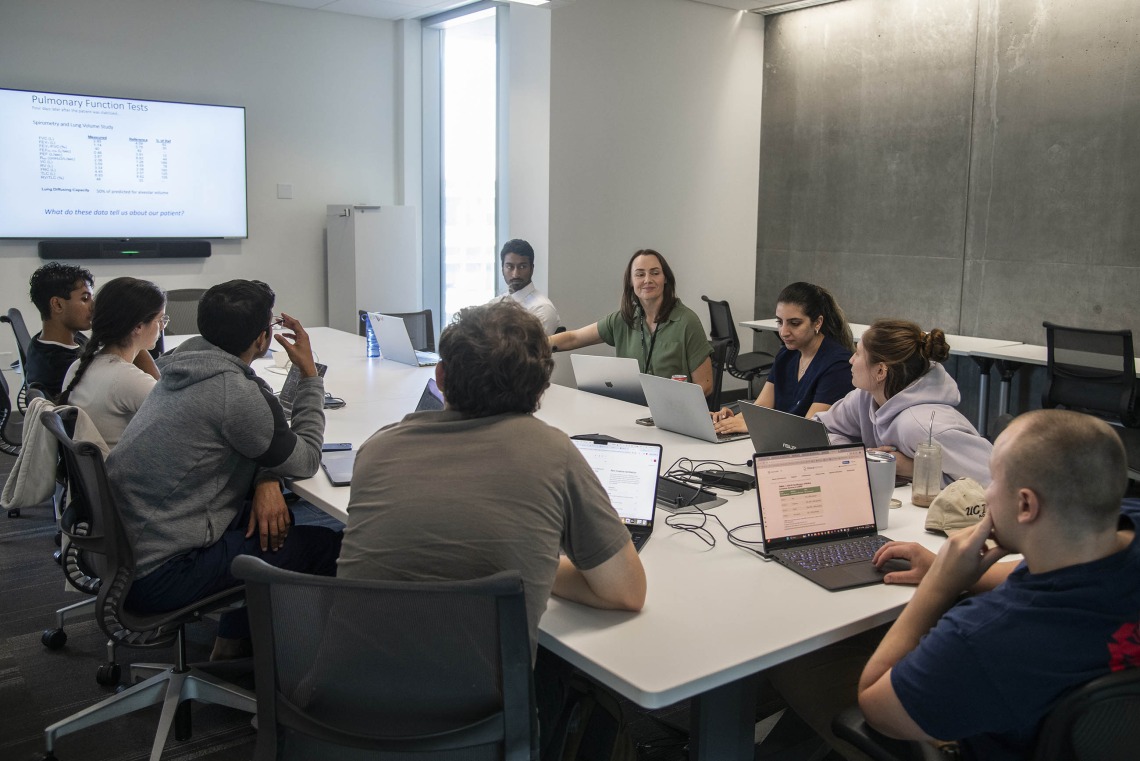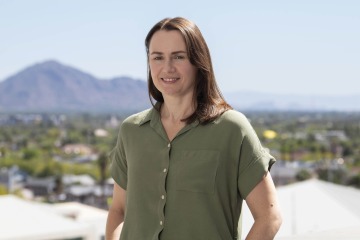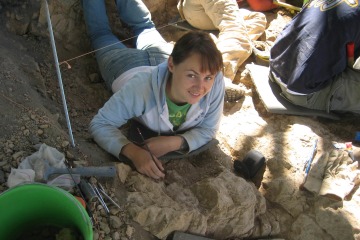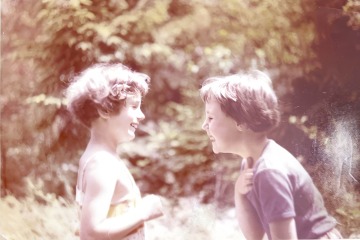Anthropology provides backbone to Glowacka’s work
College of Medicine – Phoenix assistant professor lays solid foundation for future health-care providers through her teaching of anatomy.

An anthropologist, Halszka Glowacka, PhD, first took anatomy as a graduate student and loved it so much, she now teaches anatomy of the head and neck.
Routine dental checkups send some people spiraling into a panic.
Not Halszka Glowacka, PhD.

Halszka Glowacka, PhD, said she feels lucky to both teach and research.
A meticulous flosser and brusher, she never misses those semiannual visits.
“My dentist loves me,” laughed Glowacka, an assistant professor in the University of Arizona’s College of Medicine – Phoenix’s Department of Basic Medical Sciences.
And not just because of Glowacka’s A-plus oral hygiene. The two have a lot in common, actually. An anthropologist, Glowacka is co-director of the Clinical Anatomy Block and teaches anatomy of the head and neck to first-year medical students.
“I get very excited when I talk about the chewing system and teeth,” Glowacka said, adding that her dentist happily shares Glowacka’s published work with her peers.
“She loves talking about my research,” said Glowacka, who is eagerly awaiting the time her 4-year-old daughter’s and 2-year-old son’s baby teeth can be part of her tooth collection, which so far only includes one from a family pooch. “She loves that I do what I do.”
That feeling is mutual, too.
Beyond bones
Glowacka came to the university to teach anatomy in 2018, but she learned her way around the lab well before then. Though she earned her doctoral degree in anthropology from Arizona State University, she completed her anatomy training at UArizona’s College of Medicine – Phoenix. Glowacka also worked as a teaching assistant for the gross anatomy lab director.
“The more that I taught, the more I liked it and the more interested I became,” she said. “It got to the point where I thought, ‘I want to teach anatomy.’ It wasn’t my original intention, but I just loved it.”
Anatomical knowledge lays the foundation for the future health-care workers she teaches and as an anthropologist who studies the primate skull and specifically how their teeth and faces are adapted to diet, Glowacka gives students a perspective on studying human anatomy, too.
When working with skeletal remains, it’s tempting to view them in isolation, but it’s important to consider them as part of a whole system, Glowacka said.

Halszka Glowacka fell in love with field work as an undergrad. This photo from 2006 was taken in Rudabánya, Hungary, while she was looking for fossils. (Courtesy of Halszka Glowacka)
“As an anthropologist, it’s really easy to only think about the bones and not the soft tissues that surround them, which are so important,” she said. “You don’t really think about it if you don’t work in anatomy and see it on a regular basis. I’ve gained a much deeper appreciation of the anatomy of the skull because I teach anatomy to medical and allied health students.”
Glowacka has done field work in Hungary, Rwanda and Ethiopia. She said that while it’s thrilling – after hours of meticulous digging – to discover a well-preserved bone, it’s every bit as gratifying as teaching.
“I also love hearing from my students, ‘Wow, you made this so much easier for me and I actually understand the cranial nerves now,’” Glowacka said. “That feels really amazing to me.”
She considers it payback for all of those who paved her journey into the world of science. “I was lucky to have mentors and people that I met along the way who fostered my interests,” she said.
Discovering nature
Glowacka’s love of the natural world started at an early age. Born in Poland, she spent the first years of her life in Europe. Her grandfather was an archaeologist – an anthropology-adjacent field, Glowacka noted – and her grandmother a bee biologist. So, when she and her older sister were growing up, they would, as Glowacka put it, “spend summers frolicking in nature.”
“It was really amazing,” she said. “I just grew up with the natural world as part of every day.”
The sisters helped collect samples and hung around other scientists. That put Glowacka on the path to studying zoology. An anthropology class she took on a whim made her shift course.

Halszka Glowacka, right, and her older sister, left, spent summers as young children exploring Poland’s landscape with their grandparents. (Courtesy of Halszka Glowacka)
“It wasn't anything that I was considering as a career, and I had a professor who was so passionate, and the way he described his research and anthropology made everything come to life,” she said.
She works to do the same for her students.
“Some aspects of anatomy can feel a bit dry,” she said. “Sprinkling a little bit of your own research might pique somebody’s interest and make them pay a little more attention. I try to do that as much as I can.”
Evan M. Garofalo, PhD, the UArizona College of Medicine – Phoenix’s clinical anatomy block director, said Glowacka is great at guiding students through the challenges of anatomy and medical school.
“She does it with expertly considered course materials, humor, a great design aesthetic and enthusiasm,” Garofalo said.
Back to the field
The mother of two squeezes in 5 a.m., at-home CrossFit workouts before heading to work, but don’t ask her what she does in her free time.
“That’s a personal attack for somebody with small children,” she said, smiling.
The COVID-19 pandemic and having little kids curbed her field work, but Glowacka said she is looking forward to getting back to research, hopefully the summer of 2025, in Rwanda at the 12-acre Ellen DeGeneres Campus of the Dian Fossey Gorilla Fund. It’s a project years in the making that gives her a chance to study what happens on the, uh, other end of the digestive tract.
“We're looking at gorilla poo to tell us something about how the chewing system works,” she said.
By putting the samples that have been collected for several years through a series of smaller sieves, researchers will get the straight scoop on how efficient gorillas, ranging from juveniles to older adults, are at eating their food.
Glowacka said she’s looking forward to the data she’ll collect, even if it’s a topic that others may not find … glamorous.
“Yeah,” she said, “I think I probably wouldn’t bring it up at a dinner party.”

